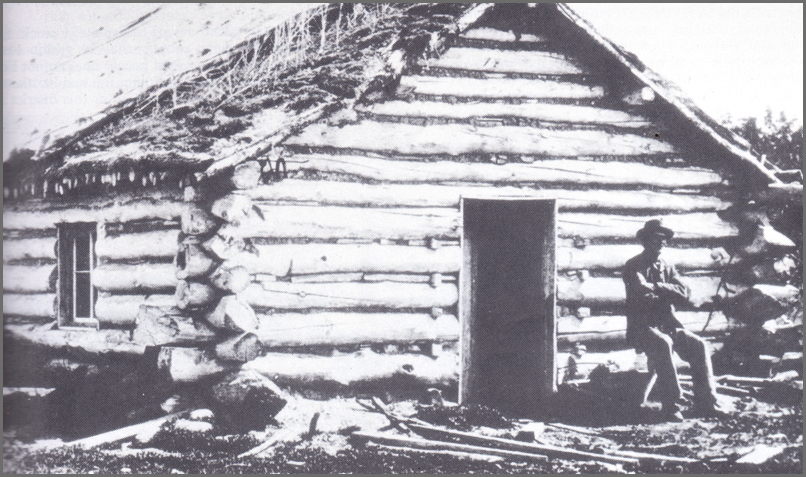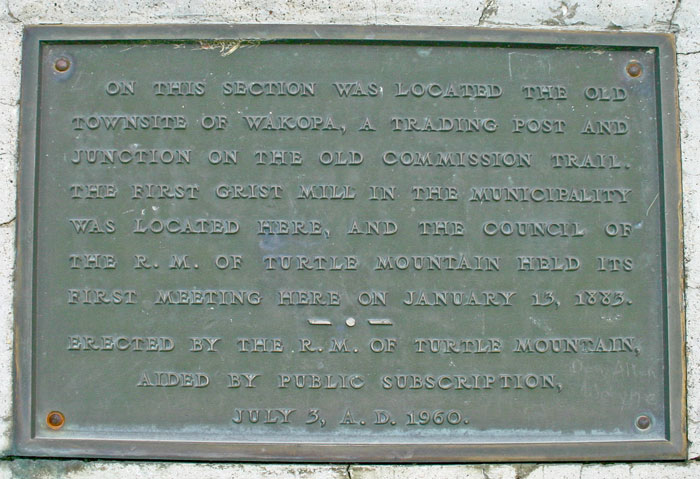| Index |
|
3.
The Village - "Old Wakopa"
 With Wakopa established as a convenient stop on the Commission Trail, and as a place to get supplies and a place to stay, it wasn’t long before La Rivière was joined by others, and the village began to grow. In 1878 Finlay Young, John, Henry and Tom Coulter, William Henderson, Robert Cowan and the Weirs settled in the area. They were quickly followed by the Harrison Brothers and Mr. Williams who built a sawmill and gristmill powered by water wheels and using grinding stones brought from France. Soon the first sod and log homes gave way to buildings of milled lumber. The first frame house in the Turtle Mountain area was built in 1880 In 1880 Williams built a store and took over the post-office duties; The Harrisons and Williams built a boarding house on the North side of the trail, and a large livery barn on the South side of the village. Billy Weir opened the first blacksmith shop and Bob Tyler another, these were essential services for farmers. Several houses were built by 1883 and the village had become a very busy centre. It has been said that in one day, during the latter part of May of 1882, one hundred and two settlers passed through Wakopa, on every mode of travel imaginable. After a short absence, one settler noticed that: “On my return that spring to Old Wakopa it was humming with activity. A new boarding house was in the process of being built on the north side of the Commission Trail, which was the town's main street. A livery barn was built in the southern outskirts due east of the sawmill, west of the mill and around the bend of Long River stood the grist mill. “ When George Scott arrived in 1880 he found a busy place with La Rivière keeping over 100 head of cattle in small stables. He had planned on settling further east at Crystal City, but his son reports that after meeting the people and celebrating May 24th with dinner at La Rivière’s Inn, decided to stay. Rev. W.O. Armstrong, writing of his 1880 trip to the region gives the place high praise… “Here at La Riviere’s we eat the best and biggest potatoes that we have ever seen, and our horses are treated to as clear and full oats as they have ever revelled upon. We were shown very fine samples of wheat, which yielded on La Riviere’s farm twenty‐five bushels of wheat to the “arpent” upon the sod the first year. “  Finlay Young’s
first house NE 20-1-18.
Being the first village in the southwest corner Wakopa was home to many other firsts. It was in 1879 that Lee Severne, La Rivière's son-in-law became postmaster of the first post office in the Turtle Mountain area, this would have been an informal arrangement. Before the establishment of “Official” post offices, each settlement would find someone to fetch the mail from the nearest post office and bring it to a central place, usually the first store. In 1880 Wakopa had its first death. Two men working for La Rivière got into a heated argument during milking one evening. One fellow got up off his stool and threw it at the other, hitting him on one of the temples, killing him instantly. The aggressor took flight and hid in a coil of hay northeast of the townsite. The next day the R.N.W.M. Police noticed the displaced hay and with help uncovered the assailant. Wakopa Post Office was officially established on March 1, 1882 with Clovis Guerin as the first Postmaster. His duties were light. When the mail arrived from Emerson, it was dumped into a big box and each settler hunted out his own. The same box served as a Lost and Found depository. Later the post office was moved to C. W. Williams' store. The first church service recorded in the Turtle Mountain district was bilingual and took place in La Rivière’s store in February of1879. The clergyman, I.O. Armstrong, gave two sermons, one in English and one in French. He felt that it was hard enough for men and women who were out of training to endure even one, but the congregation was patient and sang hymns with gusto. Mr. La Riviere and his family were devout Roman Catholics, with the exception, according to local tradition, of his Indian wife who had little use for religion of any kind. By 1880, Wakopa had become the business centre of the district, and it was here in that year that the first Presbyterian service was held conducted by the Rev. J as. Robertson, the Home Mission Secretary of that denomination. In 1881, the Rev. Wm. Patterson, later of Cooke St. Church, Toronto, made his headquarters at Wakopa and travelled the district on foot ministering to the people under his charge. The first school erected in the Turtle Mountain and the Souris Basin area was built at Wakopa in 1882, named Wakopa No. 308. The first steam power butter factory was started by John Hettle, on Sharpe’s Creek in 1885. A. Sharpe and the Young Bros. were directors. The Scott family set up a cheese factory on, NE 26-1-19. The first person buried in the cemetery in the bush beside the school at Wakopa, was John Axford. Since Wakopa was the only settlement in the district, the Council of Turtle Mountain held most of its meetings there during 1883 and 1884 until school houses were available. An American Customs Office was located in Wakopa, with C. W. Williams the Customs Officer. The exports were mostly animals for breeding purposes, buffalo bones, and settlers' effects, testimony to the continuing migration to the western plains of the United States. In 1888 the Customs Office was moved to Killarney after Williams opened a store there. Being so close to the border put Wakopa on the line of border stations designed to allow the NW Mounted Police to keep an eye on things. Wakopa became a depot. Like so many of those first pioneer villages, the life span of Old Wakopa was short – the emphasis quickly turned to the new towns on the new railway lines. When the grist and saw-mill ceased operation, buildings were taken down or moved away, until other than a few basements, the site once more became part of the original landscape. The waters of Long River, now flow leisurely through the old dam site, on to the Pembina River. But here the story of Wakopa diverges from the regular pattern. Wakopa had a second life.  The inscription on the cairn commemorating “Old” Wakopa reads: On this section was located the old townsite of Wakopa, a Trading Post and junction on the old Commission Trail. The first grit mill in the municipality was located here, and the Council of the R.M. of Turtle Mountain held its first meeting here on January 13, 1883. Erected by the R.M. of Turtle Mountain, aided by public subscription. July 3, A.D. 1960 |
